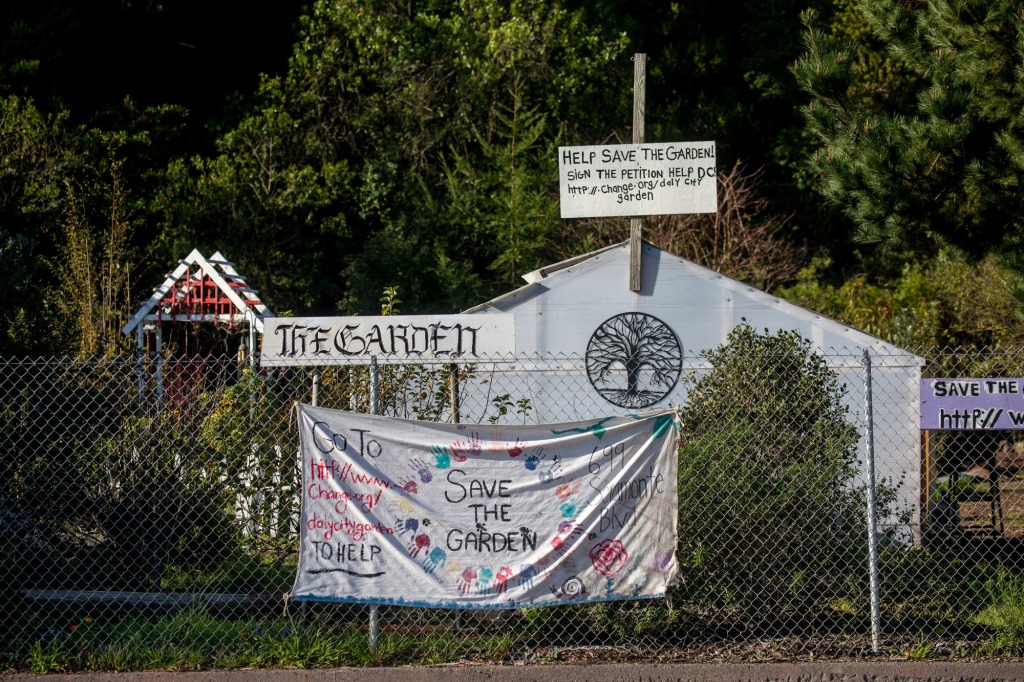The Jefferson Union High School District has a bold plan to boost school revenues and teacher retention: a massive development that includes apartment towers, shops and offices, and subsidized housing for educators built on surplus school property.
But one major obstacle threatens the Serramonte Del Rey plan in Daly City, and it’s not the size, density or future traffic snarls. It’s a fruit and vegetable garden. About 3,600 people have signed an online petition to curb the project and save a community garden the district has hosted for about two decades.
And Daly City’s City Council looks inclined next month to vote for carrots, corn and elderberries over the proposal for housing and a broader tax base. But not without debate.

School board member Kalimah Salahuddin said the financial health of the district and better resources for teachers and students should take precedence over saving a community space used by just a few dozen residents. “I don’t understand why we’re letting a garden,” she said, “stand in the way.”
The dispute highlights a decades-long struggle to create new affordable housing in the Bay Area, particularly for educators and school staff.
The Bay Area remains one of the least affordable regions in the country for teachers looking to buy or rent a house or apartment. The median teacher pay in San Francisco and the East Bay is about $86,000, and about $90,000 in the San Jose metro area, according to a recent study by online broker Redfin. The Bay Area median home price now exceeds $1 million, and rents have returned to pre-pandemic levels.
Redfin estimates a typical single teacher would find it nearly impossible to fit housing costs into a budget and still have money left over for groceries and living expenses.
Efforts to build teacher housing in San Jose have stalled with the pandemic, and charitable efforts by Facebook and others have had limited impact on the growing problem, teacher advocates say.

The need hits particularly hard in the Jefferson Union High School District, which encompasses Daly City, Brisbane, Pacifica and Colma. The district has the lowest salaries in San Mateo County and loses about one-quarter of its staff every year, administrators say.
The high turnover hinders efforts to strengthen instruction and keep veteran teachers in classrooms, said district superintendent Toni Presta. “We can’t pay the salaries,” Presta said, noting that most other districts in the county are boosted by a tax base resting on major biotech and tech companies. “Our goal is really to raise a funding stream for the district.”
The district’s plan consists of two parts: initial construction of 122 subsidized apartments for Jefferson Union teachers and staff, and a second, broader proposal for roughly 1,200 units, including high-rise apartment towers, walking trails and shops.
Construction on the teacher housing has begun, and the apartments are expected to open in the spring. At least one-third of the districts’ employees have expressed interest.
But the major expansion on the 22-acre campus would put an apartment tower on the site of the community garden.
To some, the collection of flowers beds, trees, and vegetables serves as an Edenic retreat for community members and students. To others, it’s a ramshackle patch on the former site of school tennis courts, mostly neglected until the recent controversy flared.
Debbie Santiago, who until recently lived near the garden, said she enjoyed the space for 10 years. She led the online petition to save a property she could once see from her balcony.
Having a shared, pastoral space has provided solace for residents during the pandemic, Santiago said. She also values the personal connection to the earth that’s central to her native heritage from the Washoe Tribe.
“We honor all living things,” Santiago said, adding that the district could make the project work and spare the garden. “There’s room for the garden, and there’s still room to have other housing.”

The Loma Prieta chapter of the Sierra Club opposes the project, too. In a letter to the City Council, the group urged a redesign “as a transit-oriented project that includes the existing community garden in its current location as a community benefit.”
But district leaders and educators point to the pressing need to develop new income for the district, including a bolstered tax base and what’s expected to be millions of dollars in annual lease payments from the property’s eventual developer.
The project was scheduled to be considered by the City Council this fall, but the hearing has been delayed to January as council members wrestled with the issue.
In September, council members sought more information about how affordable the units will be and expressed concern about preserving the garden. “You can’t just move it,” said councilmember Pamela DiGiovanni. “That’s impossible.”
Alex Melendrez, a housing activist with Peninsula for Everyone, said a large coalition of housing and education groups support the plan but seem to be hitting a familiar wall. “The district is bending over backwards to meet the concerns of a very small minority,” he said.
Presta said the garden has become a destination for homeless residents, and the district has discouraged students from gathering there to tend one of the small vegetable beds.
She’s also hoping for a compromise. “We’re really open to building what works for the community,” Presta said. A new garden in a different location has been included in the plan, but, she said, “It is going to be smaller.”











